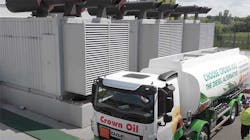Data Centers Embrace Vegetable Oil as Cleaner Fuel for Generators
A growing number of data centers are turning to vegetable oil to reduce their impact on the environment. This week Compass Datacenters became the latest company to adopt fuels based on hydrotreated vegetable oil (HVO) to fuel the generators that provide backup power for their data centers.
Compass says that early tests of show that the use of HVO can reduce the greenhouse gas emissions from its generators by as much as 85 percent. That’s why HVO is emerging as an important bridge to cleaner backup power, allowing data centers to move off of diesel fuel without having to replace thousands of generators that are both expensive and mission-critical.
The initial rollout will include generators at Compass campuses in Northern Virginia, Arizona and Texas, with Foster Fuels providing the HVO. Compass Chief Technology Officer Adil Attlassy says the initiative “will make our generators far more sustainable. Additionally, we are significantly reducing particulates and sulfides as compared to fossil fuels, eliminating diesel’s dirty smoke plume.”
The Compass announcement is part of a larger shift in the industry, which includes some of the largest operators. While it hasn’t made any press announcements, Equinix is laying the framework for broad adoption of HVO in its global data center footprint. Digital Realty has begun using an HVO blend in one of its Paris data centers, and STACK Infrastructure, Kao Data and Ark Data Centers are also testing the use of HVO in backup generators.
“HVO fuel is dramatically better for the environment compared to traditional, mineral diesels,” said Simon Lawford, Technical Sales Manager at Crown Oil, the fuel supplier for Kao Data, “It is 100% renewable, biodegradable, sustainable and non-toxic.”
Many data center operators see hydrogen fuel cells as the most sustainable long-term solution for backup power. But hydrogen is years from viability at scale in production systems, and HVO is a promising option that can slash greenhouse gas emissions and works with existing equipment.
There are challenges with HVO, including whether production can keep pace with the demands of fast-growing cloud campuses. But hyperscale customers are now demanding greener options, making sustainable backup power a key competitive factor for data center developers.
Microsoft Drives Shift Away from Diesel
Diesel generators play a central role in ensuring that mission-critical data center applications never go offline, as part of a redundant electrical infrastructure that also includes uninterruptible power supply (UPS) systems and batteries. With generators deployed at virtually every data center around the globe, transitioning off diesel fuel is a big task.
A key turning point in the data center industry’s approach to backup power came in July 2020, when Microsoft said it will to eliminate its reliance on diesel fuel by the year 2030 as part of its goal to be carbon negative. With its deadline, Microsoft set in motion a push to replace diesel generators with cleaner technologies.
In addition to building its own data centers, Microsoft has been a leading customer of data center developers, leasing hundreds of megawatts of capacity from companies that provide wholesale data center space. Almost immediately, developers began seeking alternatives to diesel-based power to remain relevant in the hunt for future business from Microsoft and other hyperscale operators.
The critical role of backup generators in keeping web sites and applications online was clear last year, when diesel generators kept Texas data centers online during a “deep freeze” power crisis, noted Sean Farney, Executive Director for Data Center Strategy and Innovation at JLL.
“We need generators, and they’re not going anywhere for a while,” Farney told DCF in a recent podcast. “They have a huge installed base, are extremely reliable, and have a global distribution replenishment infrastructure, so when you run out, a truck comes and fills you up.
“But if you come in and bring an alternative fuel, which burns cleaner and reduces your carbon impact across a fleet of thousands or 10s of thousands of units, that’s a that’s a pretty good compromise,” said Farney, who was previously an executive with Kohler Power, a generator vendor. “Replacing fuel doesn’t change your operations and maintenance protocols, and you can drive down your emissions. That’s a smart approach that evolves the current technology.”
More Operators Testing Cleaner Generator Fuel
HVO (hydrotreated vegetable oil) is a synthetic “biodiesel” fuel developed from vegetable oils and fats, including feedstocks like tall oil, soybean oil, waste cooking oil and animal fats. It has similar chemical properties as diesel oil produced from fossil fuels. The source oils are heated with hydrogen and catalysts at high temperature (typically 300 to 390 C) and pressure.
The resulting fuel requires no major modifications to existing infrastructure and can be used as a direct replacement for diesel. It eliminates microbial growth, which generates sludge that can contaminate fuel lines and potentially lead to engine shut down. Major vendors including Caterpillar, Cummins and Kohler Power have approved HVO for use in their generators.
Crown Oil delivers HVO fuel, a diesel alternative, to generators at the Kao Data Center facility in Harlow, England. (Image: Kao Data)
In June 2021, Microsoft said the backup generators at its new data center in Sweden will run on a fuel that incorporates tall oil, a renewable byproduct of forestry and paper production. Microsoft worked with Caterpillar to ensure that Evolution offers the same technical performance as traditional fuels, with fewer net emissions. That was the first of a number of single-facility implementations.
- In July 2021, Kao Data Centers transitioned all the backup generators at its Harlow, England campus to HVO. “It shows how our industry can take a simple and highly beneficial step forward for the good of the environment,” said Gérard Thibault, Chief Technology Officer at Kao Data.
- In February, Digital Realty said its Interxion PA8 facility in Paris would use HVO in its generators. Fabrice Coquio, President of Interxion France, called the move “another proactive step in implementing our strategy to reduce our carbon footprint, and to lead the way as an industry leader.”
- STACK Infrastructure has been testing HVO with Caterpillar since early 2021, and has included an HVO-capable Caterpillar model in the design for its new TOR01 data center in Toronto. “Our adoption of HVO-fueled power technology can be seen as a positive use-case for the industry and forward-thinking use of electricity in markets throughout the world,” wrote Tin Fong, Senior Director of Energy & Sustainability and Brian Medina, Director, Strategy and Development in a blog post.
Compass is going a step further, implementing HVO in data centers across three major markets. “Backup power needs to be part of the sustainability strategy, and Foster Fuels is providing us with an innovative, scalable solution that we expect will become an industry standard,” said Nancy Novak, Compass Chief Innovation Officer. “Our decision to adopt HVO-based biodiesel for generators is consistent with our previous efforts, such as CarbonCure concrete; both are focused on GHG reduction.”
Foster Fuels President and CEO Watt Foster said the Compass rollout is “a result of close collaboration between our teams to address an important issue. Our ultimate goal is to make HVO renewable diesel fuel available throughout the U.S.”
“Our ultimate goal is to make HVO renewable diesel fuel available throughout the U.S.”
Watt Foster, Foster Fuels
Equinix Studies HVO for New Builds
If HVO becomes more widely available, it will become easier for data center operators to adopt across their footprints. One company that’s exploring a large HVO commitment is Equinix, which operates a large global network of data centers.
In its 2021 sustainability report, Equinix said it is “piloting HVO at multiple sites and qualifying the supply chain to evaluate a transition away from diesel. … Compared to diesel, HVO can reduce GHG emissions by up to 90%.” Equinix says it is committed to:
- Using HVO-capable generators in all new build installations and retrofits where available.
- Piloting the use of HVO at existing sites and more broadly implementing the technology as available.
- Assessing the supply chain for HVO and other alternatives and working to ensure that purchases of HVO or other diesel alternatives avoid and mitigate deforestation.
HVO is “a great solution for those assets that already exist,” said David Hall, Fellow for Technology and Architecture in the Office of the CTO at Equinix, during an interview with DCF earlier this year. “We have 250 data centers, and they have perfectly good generators that represent a bunch of carbon and a bunch of investment. The problem is that the fuel source is poor, from a sustainability perspective.
“We think that globally, we can get access to HVOs that offer improvements for the emissions performance of generators, with no real impact on efficiency, and only slight reduction on absolute power output. It’s a great transition away from (diesel).”
Equinix is mindful of the potential tradeoffs. The cultivation of some source materials for HVOs, such as palm oil, have contributed to deforestation in Indonesia and Malaysia. Some countries and fuel providers have pledged not to use palm oil in their HVO products.
“We think we can source HVOs in ways that don’t require vast amounts of rain forest to be deforested in order to make the stuff to produce the HVOs in the first place,” said Hall.
Biofuels analysis firm Greenea projects that HVO production will ramp up in a big way in North America, moving from 1.9 million tons of capacity in 2020 to 12.6 million by 2025. With Europe poised for a similar increase, the supply of HVO looks to extend beyond the most problematic regions for deforestation.
It remains to be seen whether even that surge in production can keep pace with the type of growth required to support the data center market, which has seen extraordinary demand in early 2022 as cloud players and social networks race to procure cloud capacity for long-term growth. But HVO is increasingly seen as a key step towards more sustainable backup power.
“HVO has a very, very bright future,” said Farney. “It speaks to the permanence of the generator, and also speaks to the the innovative ways of thinking how to solve this kind of tough challenge.”
About the Author




